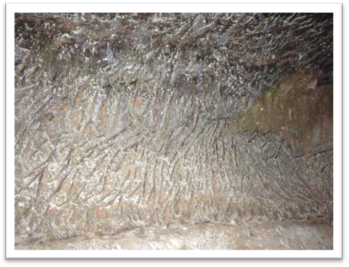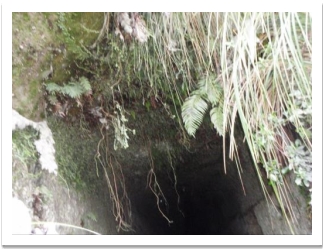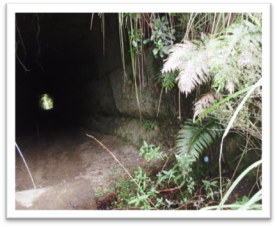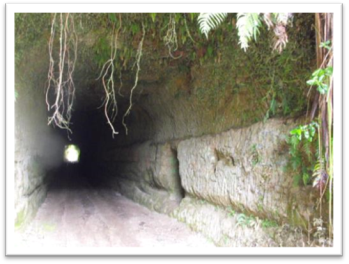HH-28B: Tunnel Road – Western Tram Tunnel

Date of Photograph: 21/07/2011
Location and Zoning Information | |
Address |
Tunnel Road, off Ngatira Road |
Current Owner |
NZ Forest Products Ltd |
Legal Description |
Pt Lot 1 Sec 105 Block XII Patetere North SD |
Zoning |
General Rural Zone |
Valuation Number |
0541120300 |
Google Maps Link |
|
Architecture | |
Date of Construction |
Circa 1900 |
Materials |
Tunnel excavated into solid rhyolite hillside. No structural supports or other building material used |
Architecture/Engineer/Builder |
Believed to have been constructed by the Taupo Totara Timber Company. |
Condition |
The tunnel itself is in good condition, although the sides are scraped due to vehicles carrying large loads. Also interior walls have recently been subjected to graffiti and scarring by vandals. |
Original Site Recommendation |
NZ Archaeological Assn – Site T15/192 - 52062 |
Current Use |
None - disused Tram Tunnel. |
Statement of Significance |
Criteria for Scheduling: 1, 6, 7, 9, 11, 12 and 13. ((1 Historical) – was associated with events, persons or ideas of importance in South Waikato history. (6 Educational) – has the potential to educate public about the history of South Waikato, item on a heritage trail, school programme potential, study of technology. (7 Archaeological) the tunnel environs are protected under the Heritage New Zealand Pouhere Taonga Act 2014, as it has the potential through investigation to provide information about the development of the timber industry in New Zealand and represents an important era of South Waikato History. (9 Technological) – is an important example of construction using particular construction methods. (11 Context) – forms part of a wider historical complex (the history of forestry harvesting and associated bush tramways). (12 Rarity) Most bush tramways were designed for a temporary existence and tunnels were not a common feature anyway. (13 Integrity) – has a good level of integrity, much of it is in reasonable condition, there have been no additions or major alterations. District Plan RulesDemolition/Destruction – DIS. Protection focus – 1, 6, 7, 9, 11 and 12. Mitigate the effects of demolition by requiring the applicant to provide Historical Documentation, which should include: the structure’s history, photographic documentation and measurements of the structure prior to demolition /destruction. Modifications/Alterations necessary for the primary purpose of improving structural performance, fire safety or physical access – CON -Refer to HH-R2. Other Additions/Alterations - DIS. Protection focus – 9, 11, and 13. Those elements associated with the historic character, use, rarity, craftsmanship and any other special elements identified in the Historical documentation, should be protected. NB. Erection of gates to secure the entrances to the tunnels is PER. Repair /Restoration of the Structure – PER. Refer to HH-R1. Protection focus – 6, 7, 9, 11, and 13. Building Materials Rule: If repair or restoration of the tunnel is proposed, where possible the materials used should be similar in type, dimensions and profile as the original Design Rule: repair or replication work should match the existing design and profile of element. Restoration of missing parts allowed where there is a high level of authenticity. Re use/Change of use- CON. Refer to HH-R1. Protection focus - 1,6,12 and 13. Any proposed change of use /re use must ensure that adverse effects on the tunnel and its environs are mitigated. Erection of gates to secure the entrances to the tunnels is PER. Disturbance of the site surface/earth works- DIS. Protection focus - 1, 6, 7,10,11,12 and 13. – Note: Any place that was associated with human activity prior to 1900 and is able to provide evidence relating to the history of New Zealand is an ‘archaeological site’ (refer to definition of ‘archaeological site’ in Section 2 of the Heritage New Zealand Pouhere Taonga Act 2014). All archaeological sites are protected under the Heritage New Zealand Pouhere Taonga Act 2014 and approval from Heritage New Zealand must be obtained prior to destroying, damaging or modifying any site. Accordingly, where the site on which a structure is located is an ‘archaeological site’ and the structure is to be repaired, added to, relocated or demolished and this involves disturbance to the surface and/or subsurface of the site, approval from Heritage New Zealand is required. |
History |
The area has had a connection with the timber industry that dates back to the end of the 19th Century. Bush tramways were the principal method of transporting felled timber to the local mills until the late 1940s. Due to the steep gradients, tram tunnels had to be constructed in places to enable the trams to travel through some of the areas with the steepest and most challenging terrain. Bush tramways and associated tram tunnels such as these represent an important example of engineering innovation. From the 1850s, bush tramways formed a common feature in harvesting the forests in New Zealand. Most bush tramways were designed for a temporary existence and tunnels in particular were not a common feature anyway. This tunnel is one of only several that remain in this District and is a rare surviving remnant of the former bush tramway system. |
Additional Photographs
Tunnel was excavated by hand. Pick marks are still clearly visible.


